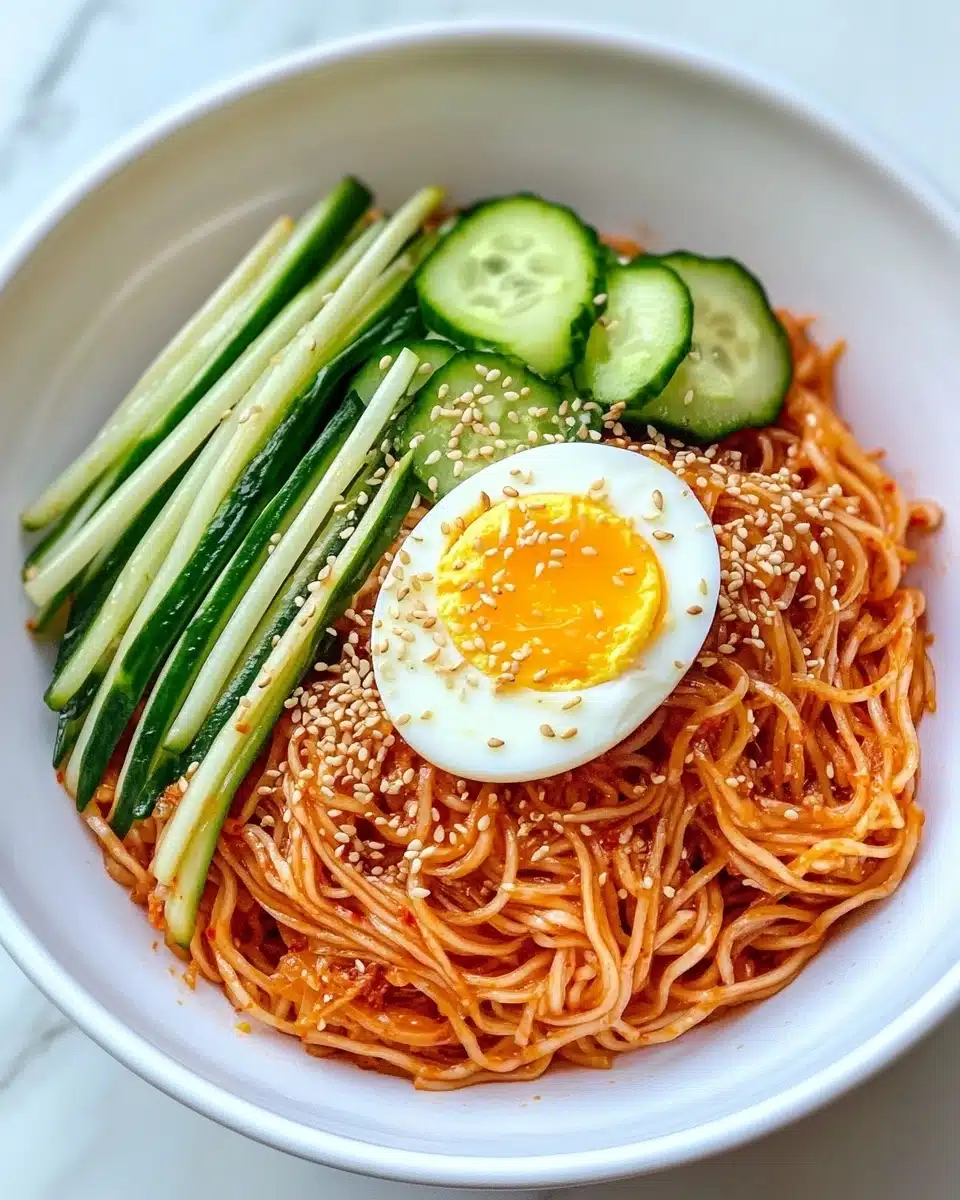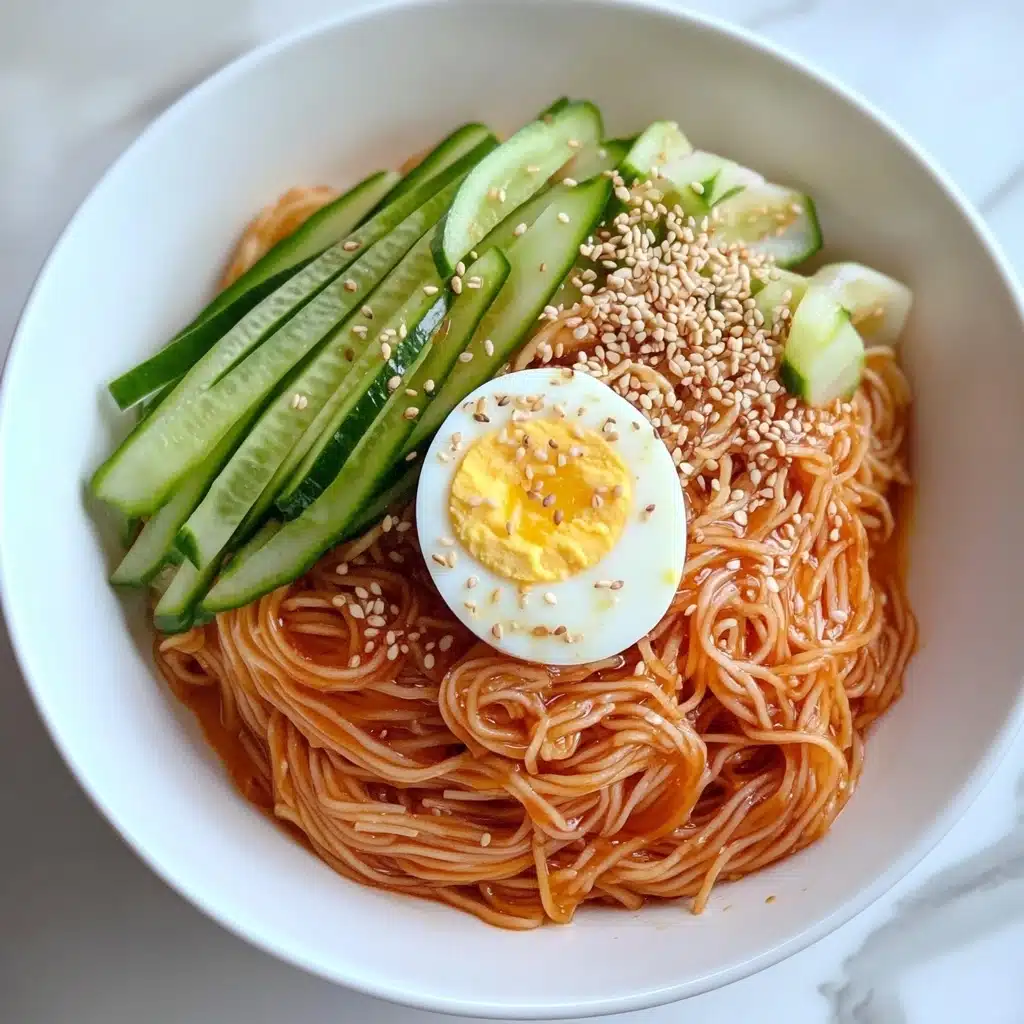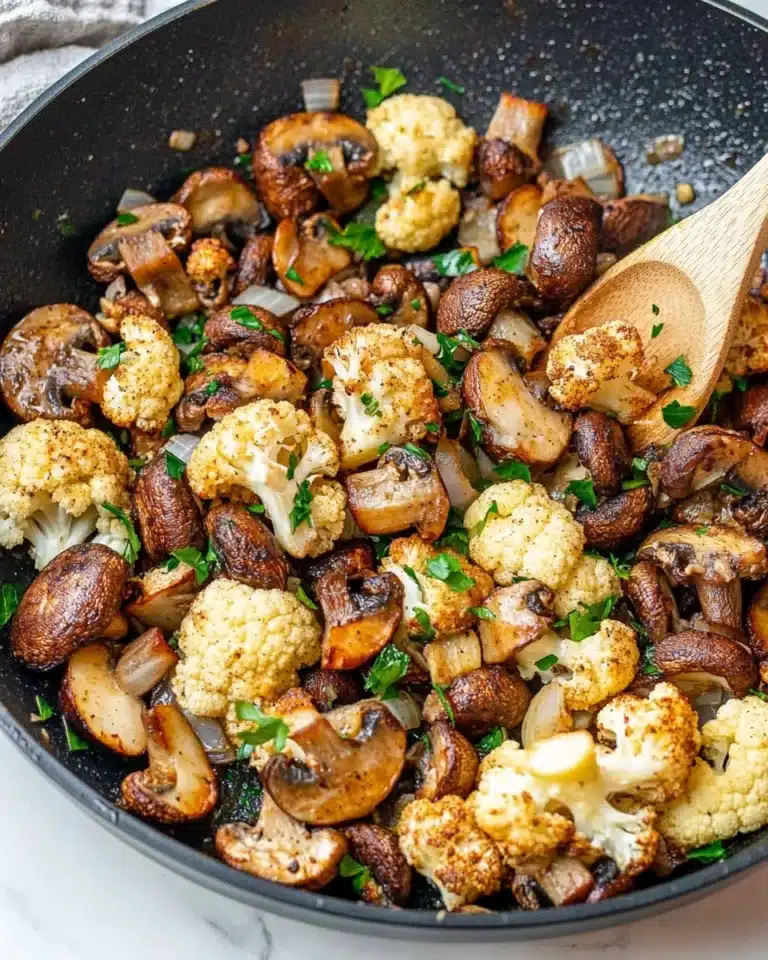Bibim Guksu (Korean Spicy Cold Noodles) is the ultimate summer refreshment—think bouncy wheat noodles, tangy kimchi, and a fiery-sweet sauce, all chilled to perfection and topped with crunchy veggies. If you love bold flavors and dishes that are quick to pull together, this is the noodle bowl you’ll crave again and again.
Why You’ll Love This Recipe
- Lightning Fast: Craving noodles in a hurry? Bibim Guksu comes together in under 15 minutes—perfect for heatwaves or last-minute lunch!
- Flavor Explosion: Each bite hits you with tangy, spicy, and sweet notes, all at once—the sauce is totally crave-worthy.
- Ultra Adaptable: Make it vegan, crank up the heat, or swap veggies for whatever’s in your fridge—the possibilities are endless.
- Soothing & Refreshing: Served icy cold, Bibim Guksu is the dish to cool you down and wake up your taste buds.
Ingredients You’ll Need
You’ll only need a handful of simple, everyday ingredients to whip up Bibim Guksu (Korean Spicy Cold Noodles). Each one plays a key role in building that signature flavor and texture—don’t worry, if you’re missing something, I’ll share swaps and tips below!
- Somyeon (thin wheat noodles): These Korean-style noodles are quick-cooking and deliver the perfect soft-but-chewy bite.
- Fermented kimchi + brine: Adds a deep, tangy flavor and lots of crunch—don’t toss that brine, it’s the secret to bright sauce!
- Gochujang (Korean chili paste): The heart of the sauce—choose extra spicy if you dare, or mild if you’re heat-sensitive.
- Fine gochugaru (Korean chili flakes): Gives the sauce bold color and a layer of roasty heat you can’t get anywhere else.
- Sugar (any kind): Just a touch to balance all that spice and acidity. White sugar is classic, but you can use brown or raw if you wish.
- Plum vinegar (or rice vinegar): Plum vinegar shines in this sauce with an extra burst of fruitiness, but rice vinegar is just as tasty.
- Sesame oil: A drizzle of this nutty oil ties the whole dish together with a gorgeously fragrant punch.
- Soy sauce: Adds depth and savoriness—Korean soy sauce is ideal, but any light soy works.
- Fresh garlic: Finely grated or minced, it bloomed right in the sauce for a zesty kick (leave this out if making ahead for later).
- Crushed sesame seeds: A sprinkle on top and in the sauce for rich, toasty flavor and texture.
- Optional Toppings – Hard boiled egg, cucumber: These classic garnishes cool down the spice and add that perfect fresh crunch.
Variations
Bibim Guksu is happiness in a bowl, and it begs to be customized! Whether you need it vegan, gluten-free, or are just raiding your fridge for fun textures, there’s a tweak for everyone.
- Make it vegan: Leave out the egg and double down on crunchy cucumbers, carrots, or even julienned radish for extra bite.
- No kimchi? No worries—simply add another splash of soy sauce and pump up the vinegar for that classic tang.
- Add protein: Top your bowl with poached or shredded chicken, tofu, or even canned tuna to turn it into a satisfying meal.
- Swap the noodles: Try soba, rice noodles, or even spaghetti—they’ll all work with this flavor-packed sauce.
- Lower the heat: Omit the gochugaru or use a mild gochujang for a gentler, kid-friendly version of Bibim Guksu (Korean Spicy Cold Noodles).
How to Make Bibim Guksu (Korean Spicy Cold Noodles)
Step 1: Grind & Prep the Sesame Seeds and Toppings
Start by grinding your toasted sesame seeds until about half of them turn powdery—you want a mix of sesame “dust” and crunchy bits. Slice your cucumber into thin matchsticks for extra crunch, and boil your eggs to your preferred doneness if you’re using them as a topping.
Step 2: Mix the Sauce
Combine the kimchi brine, gochujang, gochugaru, soy sauce, sesame oil, vinegar, half of the crushed sesame, sugar, and garlic in a bowl. Stir until the sauce reaches a smooth, glossy consistency. If you’re prepping ahead, skip the garlic and sesame oil for now—they taste best when added right before serving.
Step 3: Stir in the Kimchi
Once your sauce is perfectly blended, stir in the chopped kimchi. This adds both vibrant texture and a fermented, punchy flavor that makes Bibim Guksu (Korean Spicy Cold Noodles) truly sing.
Step 4: Boil and Cool the Noodles
Bring a pot of water to a rapid boil and add your somyeon noodles. They cook lightning fast—just 3 to 3½ minutes! As soon as they hit perfect tenderness, strain and rinse them under icy water, rubbing gently to wash away starch. Trust me, extra rinsing keeps your noodles delightfully bouncy, never sticky.
Step 5: Dress and Toss
Add the noodles and sauce to a mixing bowl and toss until evenly coated. The vibrant red sauce clings to each strand, promising flavor in every bite.
Step 6: Serve & Top
Divide the sauced noodles into serving bowls. Top generously with the sliced cucumbers, hard boiled egg halves, and a sprinkle of the reserved crushed sesame seeds. Dive in immediately for maximum flavor and refreshment!
Pro Tips for Making Bibim Guksu (Korean Spicy Cold Noodles)
- Ice Bath Rinse: For the ultimate noodle texture, dunk your noodles in a bowl of icy water—not just under the tap. This makes them springy and wonderfully cool.
- Sauce Customization: Taste your sauce before mixing—everyone’s kimchi, gochujang, and vinegar are a little different, so tweak to get the perfect balance of spicy, sweet, and sour.
- Separate Serving: If you’re serving later or to a group, keep sauce and noodles separate until just before eating to prevent sogginess and let everyone adjust spice levels individually.
- Fresh Garlic Timing: Only add fresh garlic just before eating for the brightest, punchiest flavor—if storing the sauce, leave it out and mix it in at the last minute.
How to Serve Bibim Guksu (Korean Spicy Cold Noodles)
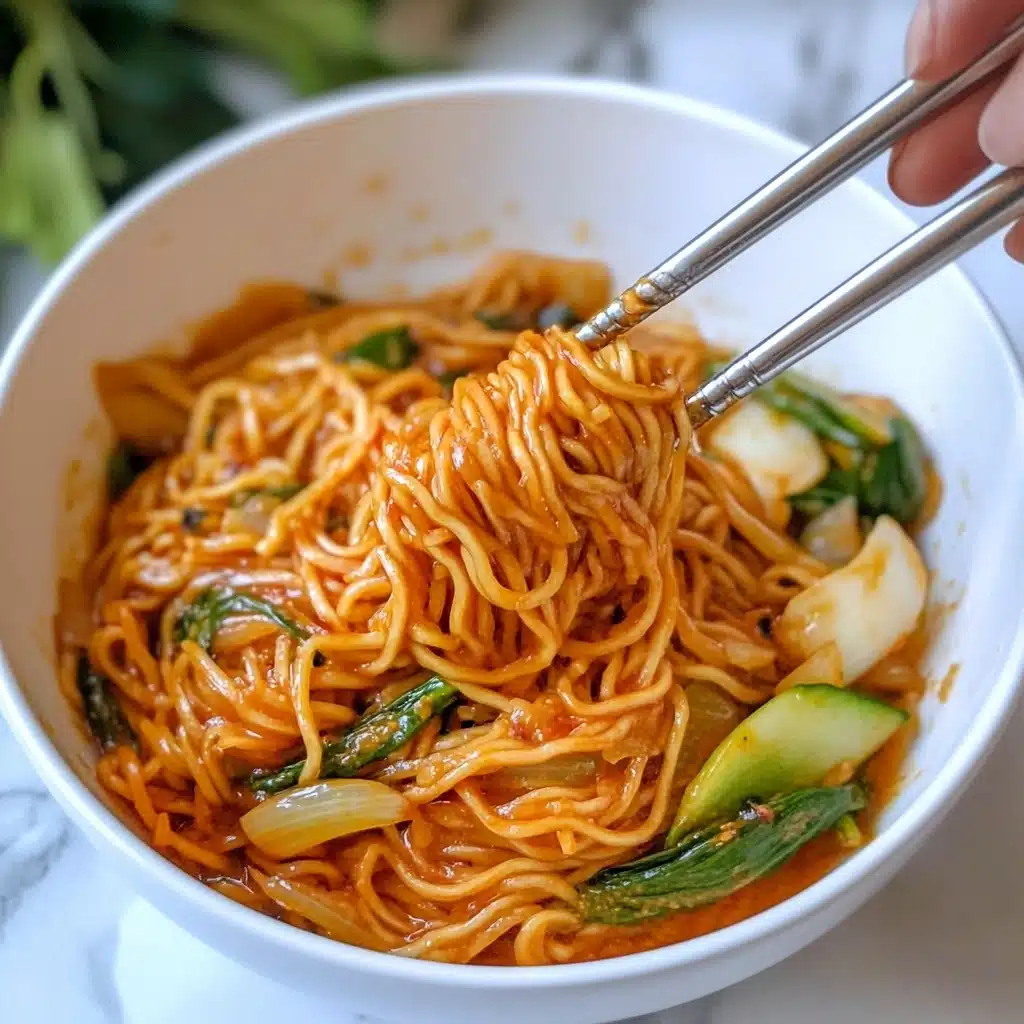
Garnishes
The classic finish for Bibim Guksu is a tumble of icy cucumber, a hard-boiled egg cut in half, and an extra shower of crushed sesame seeds. If you want even more crunch or color, toss on thin strips of carrot, red radish, or scallions. A few extra kimchi pieces on top never hurt anyone, either!
Side Dishes
Pair your noodle bowl with crispy fried Korean dumplings (mandu) or a cool, simple banchan lineup—think pickled radish, sautéed spinach, and, of course, extra kimchi. Even just a bowl of cold barley tea alongside makes Bibim Guksu (Korean Spicy Cold Noodles) into a complete, satisfying meal.
Creative Ways to Present
For summer gatherings, serve these noodles mounded over a nest of crushed ice in a shallow bowl—guaranteed to keep things frosty. Individual portions look beautiful garnished with a swirl of cucumber, bright microgreens, or edible flowers. For a “build your own” bar, set out sauces, noodles, and all the toppings for guests to customize their own Bibim Guksu bowls.
Make Ahead and Storage
Storing Leftovers
If you have extra noodles, store them undressed in a sealed container in the fridge for up to 2 days. Keep any unused sauce separate—just mix together when you’re ready to eat for the freshest taste and texture.
Freezing
Freezing Bibim Guksu isn’t recommended, as the texture of the noodles and vegetables just isn’t the same after thawing. It’s a dish best enjoyed fresh, with every component crisp and snappy!
Reheating
Since Bibim Guksu (Korean Spicy Cold Noodles) is meant to be eaten cold, you don’t need to reheat it! If your noodles clump in the fridge, rinse them quickly with cold water to loosen and refresh before dressing with sauce.
FAQs
-
Can I make Bibim Guksu without kimchi or kimchi brine?
Absolutely! While kimchi and its brine add signature tang and depth, you can still enjoy a delicious bowl by skipping the kimchi and adding an extra splash of soy sauce and vinegar to the sauce for balance. Top with whatever fresh veggies you have on hand for crunch.
-
Is Bibim Guksu (Korean Spicy Cold Noodles) very spicy?
It’s definitely got a kick from the gochujang and gochugaru, but you have total control! Use mild gochujang, adjust the chili flakes, or even skip the gochugaru if you prefer a gentle warmth. Tweak and taste until you find your perfect level of heat.
-
What type of noodles can I substitute for somyeon?
If you can’t find somyeon, don’t worry! Soba noodles, thin rice noodles, or even spaghetti will work. Just make sure to boil them until just tender and rinse thoroughly under cold water for that signature chewy, slippery texture.
-
Can I prep Bibim Guksu ahead for meal prep?
Definitely! Make the sauce in advance—just leave out the sesame oil and garlic, and add them before serving for the brightest flavor. Keep noodles and sauce separate and combine just before eating for the best texture.
Final Thoughts
I can’t wait for you to dive into a bowl of Bibim Guksu (Korean Spicy Cold Noodles)—it’s crunchy, spicy, tangy, and so incredibly refreshing. Whip it up on sticky summer days or anytime you want something bold and energizing. Give it a whirl, make it your own, and let the noodly joy begin!
Print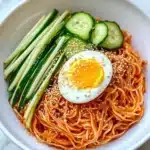
Bibim Guksu (Korean Spicy Cold Noodles) Recipe
- Prep Time: 5 minutes
- Cook Time: 8 minutes
- Total Time: 13 minutes
- Yield: 2-3 servings
- Category: Main Dish
- Method: Boiling, Mixing
- Cuisine: Korean
- Diet: Vegetarian
Description
Enjoy the refreshing and spicy flavors of Bibim Guksu, a popular Korean dish featuring cold noodles mixed with a flavorful sauce made from kimchi, chili paste, and sesame oil. Customize it with your favorite toppings like boiled egg and cucumber slices for a satisfying meal.
Ingredients
Noodles:
- 8 oz somyeon thin wheat noodles
Sauce:
- 1/2 cup fermented kimchi
- 3 tbsp fermented kimchi brine
- 1/4 cup extra spicy gochujang or mild
- 1 tsp fine gochugaru
- 3 tbsp sugar any kind
- 3 tbsp plum vinegar or rice vinegar
- 2 tbsp sesame oil
- 1 tbsp soy sauce
- 2 garlic cloves
- 2 tbsp crushed sesame seeds
Optional Toppings:
- hard boiled egg
- thinly sliced cucumber
Instructions
- Grind toasted sesame seeds until about half has turned into powder.
- Boil the eggs to your liking and thinly slice the cucumber.
- Mix together kimchi brine, gochujang, gochugaru, soy sauce, sesame oil, garlic, vinegar, and half of the crushed sesame seeds.
- Add the kimchi to the sauce.
- Boil the somyeon noodles for about 3 1/2 minutes, then rinse under cold water.
- Add the sauce to the noodles and mix well. Top with crushed sesame seeds, sliced cucumber, and hard boiled egg.
Notes
- If storing for later, omit garlic and sesame oil until ready to serve.
- Can substitute kimchi and brine with extra soy sauce for a delicious alternative.
Nutrition
- Serving Size: 1 serving
- Calories: 320 kcal
- Sugar: 8g
- Sodium: 850mg
- Fat: 10g
- Saturated Fat: 2g
- Unsaturated Fat: 5g
- Trans Fat: 0g
- Carbohydrates: 50g
- Fiber: 3g
- Protein: 9g
- Cholesterol: 70mg

